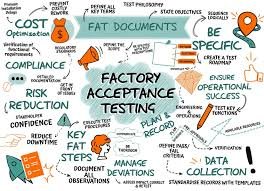How to Write a Factory Acceptance Test FAT Protocol

📘 How to Write a Factory Acceptance Test (FAT) Protocol
A Factory Acceptance Test (FAT) is a documented process conducted at the vendor’s premises to verify that equipment, systems, or instruments meet the agreed design, functional, and regulatory requirements before delivery to the site.
✅ Steps to Write a FAT Protocol
1. Header Information
-
Title: Factory Acceptance Test (FAT) Protocol
-
Document No. / Revision No.
-
Prepared by / Reviewed by / Approved by (signatures and dates)
-
Equipment / System Name & ID
-
Vendor / Manufacturer details
2. Objective
-
Define the purpose of the FAT (e.g., “to ensure the equipment meets User Requirement Specifications (URS), Design Specifications, and GMP compliance before shipment”).
3. Scope
-
Describe the equipment/system being tested.
-
State which parameters/functions will be verified.
-
Identify inclusions and exclusions.
4. Responsibilities
-
Vendor responsibilities (test execution, documentation).
-
Client responsibilities (witnessing, review, approval).
5. Reference Documents
-
URS
-
Design Qualification (DQ)
-
Functional Design Specification (FDS)
-
Applicable regulatory guidelines (FDA, EU GMP, ISPE, etc.)
6. Equipment / System Description
-
Overview of the system.
-
Critical components and utilities required.
-
Safety features.
7. Pre-requisites
-
Calibration status of instruments.
-
Utilities availability (power, air, water, etc.).
-
Test equipment required.
8. Test Procedures
Prepare test cases and acceptance criteria, such as:
-
Mechanical Checks – dimensions, weld quality, surface finish, component verification.
-
Functional Tests – power ON/OFF, alarms, interlocks, safety features.
-
Software/Automation Checks – HMI displays, data logging, recipe management.
-
Performance Tests – capacity, accuracy, repeatability.
-
Compliance Checks – documentation, manuals, certificates.
Each test case should include:
-
Test step
-
Expected result (acceptance criteria)
-
Actual result
-
Pass/Fail
-
Remarks
9. Deviations & Non-conformances
-
Procedure to document deviations during FAT.
-
Corrective action requirements.
10. Documentation & Records
-
Attach checklists, calibration certificates, test sheets, and FAT report templates.
11. Acceptance & Approval
-
Final summary of results.
-
Approval section with client and vendor sign-off.
✍️ Example of FAT Test Case Format
| Test ID | Test Description | Acceptance Criteria | Actual Result | Pass/Fail | Remarks |
|---|---|---|---|---|---|
| FAT-01 | Verify equipment dimensions | Dimensions within ±2 mm of design | 2000 mm (meets spec) | Pass | – |
🎓 Discover one of the best Complete Pharmaceutical Production Course available —click below to explore the course that’s shaping future Production Course skills.

